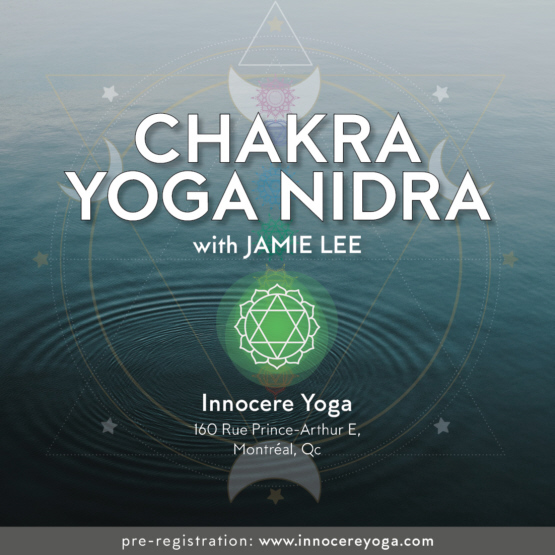| |
|
|

|
Saturday March 26th @ 3:00 - 5:00pm
Pre-registration: Innocere Yoga
The yogic chakra system is one of our oldest and most sophisticated maps of consciousness that we have. It's a cartography of being that gives the evolving soul a roadmap for where it is going in its evolutionary unfolding. Imported from the East, the chakras outline the dimensions of who we are as frequencies localized in our bodies.
Anahata chakra represents the energy content of our astral body; expressed as the central powerhouse of the human energy system. The middle chakra, it mediates between the body and spirit and determines their health and strength. Fourth chakra energy is emotional in nature and helps propel our emotional development. This chakra embodies the spiritual lesson that teaches us how to act out of love and compassion and recognize that most powerful energy we have is love.
Yoga nidra restructures and transforms our whole personality from within. With every session of yoga nidra we are actually burning our old samskaras, habits and tendencies in order to be born anew. This process is quicker than other systems that work on an external basis.
$35, comes with course materials and MP3's for home practice, limited to 17 students
|
October 16th Class one: Mooladhara chakra represents the energy content of the physical body and is symbolically understood as tribal power. When we share belief patterns with groups of people, we participate in energy and physical events created by those groups. Regardless of the 'truth' of familial beliefs, every one of them directs a measure of our energy into an act of creation. Each belief, each action has a direct consequence. This is the creative, symbolic expression of the sacred truth All Is One.
November 20th Class two: Swadthisthana chakra represents the energy content of our emotional body; which gives us our basic survival instincts and intuitions, as well as our desire to create music, art, poetry, and architecture, and the curiosity to investigate nature in science and medicine. Our creative energy draws us into an internal dialogue with the polarities of the self, our self, our conflicting inclinations, and it compels us to form external relationships to resolve these polarities.
December 11th Class three: Manipura chakra represents the energy content of our mental body; which manifests as the energy of personal power. This becomes the dominant vibration in our development during adolescence. It assists us further in the process of individuation, of forming a `self`, ego and personality separate from our inherited identity. This energy center also contains most issues related to the development of personal power and self-esteem.
March 26th Class four: Anahata chakra represents the energy content of our astral body; expressed as the central powerhouse of the human energy system. The middle chakra, it mediates between the body and spirit and determines their health and strength. Fourth chakra energy is emotional in nature and helps propel our emotional development. This chakra embodies the spiritual lesson that teaches us how to act out of love and compassion and recognize that most powerful energy we have is love.
Class five: Vishuddhi chakra represents the energy content of our etheric body; the essence of the fifth chakra is faith. Having faith in someone commits a part of our energy to that person; having faith in an idea commits a part of our energy to that idea; having faith in a fear commits a part of our energy to that fear. As a result of our energy commitments, we our minds, hearts, and lives become woven into their consequences. Our faith and our power of choice are, in fact, the power of creation itself. We are the vessels through which energy becomes matter in this life. What kind of life are you creating?
Class six: Ajna chakra represents the energy content of our celestial body; the sixth chakra involves our mental and reasoning abilities, and our psychological skill at evaluating our beliefs and attitudes. The Mind chakra resonates to the energies of our psyches, our conscious and unconscious psychological forces. Within Eastern spiritual literature, the sixth chakra is the third eye, the spiritual center in which the interaction of mind and psyche can lead to intuitive sight and wisdom. Becoming conscious means changing the rules by which we live and the beliefs we maintain. Our memories and attitudes are literally rules that determine the quality of life as well as the strength of our bonds with others. Always, a shift in awareness includes a period of isolation and loneliness as one gets accustomed to the new level of truth. And then always, new companies are found. No one is left alone for long.
Class seven: Sahasrara is our connection to our spiritual nature and our capacity to allow our spirituality to become an integral part of our physical lives and guide us. While our energy system as a whole is animated by our spirit, the seventh chakra is directly aligned to seek an intimate relationship with the Divine. It is the power of prayer (intent). It is also our grace bank account, the warehouse for the energy we amass through kind thoughts and actions, and through acts of faith and prayer. It enables us to gain an intensity of internal awareness through meditation and prayer. This chakra represents our connection to the transcendent dimension of life.
Benefits of Yoga Nidra:
Yoga nidra gives you profound experience of muscular, mental and emotional relaxation.
Yoga nidra transforms a victim of stress into a victor in life.
Yoga nidra improves the lives of people with chronic degenerative diseases.
Yoga nidra revives the dispersion of human energies at all levels.
Yoga nidra burns the old samskaaras, habits and tendencies in order to be born new.
Yoga nidra melts your mind so that you can cast good creative impressions on it thereby increasing receptivity.
Yoga nidra plays a vital role in ensuring psychological health and well being of children.
Yoga nidra augments the capacity of receptivity and attention and awakens the joy of learning in young students.
Yoga nidra helps in regaining the point of balance and harmony in every sphere of existence.
Yoga nidra provides the perfect conditions for intra-uterine growth of the fetus.
Yoga nidra acts as an ideal antidote to preserve childs natural abilities and creative faculties in the most effortless and spontaneous way.
Yoga nidra helps in combating diseases that have sprung up with new dimensions and reached a peak in the last few decades.
Yoga nidra decreases the requirements for analgesic, hypnotic and sedative drugs.
Yoga nidra as a Process of Releasing Yoga nidra restructures and transforms our whole personality form within.
Yoga nidra is a practice which can be widely applied in the modern world to improve the quality and happiness of human life. It is a simple yet profound technique and has been used in the following fields:
Relaxation: yoga nidra is the best and most permanent method of inducing deep relaxation of the entire human structure and personality.
Meditation: it is a meditative technique.
Psychological problems: yoga nidra acts directly in eradicating deep-rooted psychological complexes, neuroses, inhibitions, etc. It is an advanced psychiatric tool.
Psychosomatic ailments: yoga nidra helps to remove a vast number of ailments that are predominantly mental in cause, such as high blood pressure.
Sleep: yoga nidra induces and improves deep sleep. It is a non-chemical tranquillizer that quickly removes insomnia.
Physio-psychological rejuvenation of the entire human organism can be brought about by yoga nidra. The physical, pranic and mental levels of man are directly recharged.
Mind exploration and awakening: yoga nidra opens up the potential of the human mind and also awakens the faculty of intuition.
Learning, education and intelligence: yoga nidra is a profound educational tool. Through investigations and tests, it has been found to bring extraordinary improvements in both the absorption and retention of information from external sources as well as tapping of knowledge within one's own mind. It heightens intelligence in all meanings of the word.
The rotation of awareness harmonizes the nervous system, balances pranic flows and renders the mind-one pointed. Yoga nidra has a vast number of other applications and can be practised by everyone, young and old, male or female. It is thoroughly scientific and tested. It requires no belief or blind acceptance of a dogma, it only requires practice.
Definition
The word yoga means inner communion; the process that leads to this state. Nidra means sleep. Thus yoga nidra can be defined as yogic sleep. It is both the name of a specific practice and a state of being. The mechanics of the practice are easy to understand and define, but the state of yoga nidra will be understood differently by different people as follows:
Sleep: to a person who is tired, exhausted and constantly worried, the state of yoga nidra will mean only one thing... a deep, refreshing sleep. Nothing more, nothing less. Many are the people who practice yoga nidra alone or attend yoga nidra classes only for one purpose: to sink into the oblivion of sleep. And there is absolutely nothing wrong with this, since your deep sleep will being many benefits. In yoga nidra lessons one is generally asked to remain wakeful, but if you cannot do this, do not worry... enjoy the sleep. Sometime in the future you can try to remain awake.
Psychic sleep: to other people, possibly those who have been practicing yoga nidra for an extended period of time, yoga nidra will mean a state of conscious dreaming, where one will see visions of the subconscious mind. One will seem to hover in a state midway between sleep and wakefulness. In this state one will confront subconscious problems, suppressions, fears, etc. Regular practice will slowly clean and polish the mind.
Sleepless sleep: this is the highest state of yoga nidra where one balances on the razor's edge between introversion and extroversion. This is the path of Sushumna and corresponds to the awakening of the kundalini. This is the blissful and mystical state of yoga that corresponds to superconsciouness. It has been described by innumerable yogis, saints, bhaktas and sages throughout history. In the great yogic scripture called Yogataravali, Shankaracharya has written: When sankalpa (desires) and vikalpa (fancies and imaginations) are rooted out then one is influenced no more by karma. When sankalpa and vikalpa are removed by constant yogic practice the ever blissful state of yoga nidra dawns.
We have defined three specific stated of yoga nidra. As a practice we can describe it as a method of inducing physical and nervous tranquility, as a method of ridding the mind of chronic tension, and of inducing inner knowledge and meditation. It nulls the rational thought processes and brings inner peace.

|
|
| |
|
|
|
|